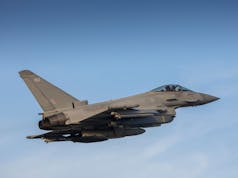Saab has revealed a new dedicated Counter-Unmanned Aerial System (C-UAS) missile named Nimbrix, which the company says is designed to defeat the growing threat posed by small drones on the battlefield, the company stated.
The missile, Saab’s first purpose-built counter-drone weapon, is being developed with a focus on low cost, rapid deployment, and versatility. According to Saab, Nimbrix will feature a target seeker, a hard-kill warhead, and a compact design. The missile will have a range of up to 5 km and employ an active seeker to track aerial targets. Saab added that the warhead can defeat drone swarms by using an air-burst mode.
Stefan Öberg, head of Saab’s business unit Missile Systems, said: “Nimbrix is our answer to the unmanned aerial threats which have escalated in the last few years. It is cost-effective which is critical given the proliferation of UASs on the battlefield. Nimbrix benefits from our long experience of air defence, together with an agile way of responding to new needs.”
The system is intended to operate as a ground-based missile that can be used independently or integrated into wider air defence architectures. Saab said Nimbrix is being designed with flexible mounting options to meet customer requirements, whether on vehicles or fixed installations.
By focusing on affordability, Saab stated that Nimbrix will allow for larger numbers of deployed missiles, improving overall coverage against hostile drones.
Customer discussions are already underway, and Saab expects first deliveries in 2026. The company confirmed the system will be publicly displayed for the first time at the DSEI defence exhibition in London from 9–12 September 2025.














Will it be cheaper than the drone it takes out?
good question
Will it be cheaper than what it’s defending?
This is the Issue, It can be like using a Sledge Hammer to crack a nut, or that’s the danger. but, you have to also look at what the cost may be in lives or equipment.
This is just the latest battle in Offensive and Defensive warfare.
👍
There could be circumstances where that walnut presents a serious risk and the sledgehammer is all that is available. Dont forget some drones are big and expensive.
Agree but the economics do count. If an enemy…let’s say Russia is mass producing cheap kamikaze drones then the defence system has to be cheaper. Most likely that means ECCM, Direct energy weapons etc
Hell even an enlarged 8 or 6 bore shotgun with a rudimentary TV scan and track system would suffice. We’ve got to be able to knock down so many that the enemy cannot match production Vs destruction.
This missile looks useful however for higher end drones that you don’t want to waste a land Ceptor missile on.
The UK armed forces need a cheaper effective option, especially as Russia/ China’s latest FPV drones are guide by wire and virtually unjammable.
Cheap fibre optics – the plastic stuff melts at quite low temperature – 100 to 150 degrees C. A short burst with a laser would cut the Comms link. Silica fibre optics melt at much higher temperatures so require more energy to melt and would require a longer and more powerful laser. So whilst your comment regarding being virtually unjammable is true today but it probably won’t be in a few months.
I think no one has explored the possibility of really cheap anti drone weapons. These dont need a 5 km or even 5 mile range.
We need something ultra cheap and with two abilities apart from that. Something throw away. It needs the complexity of something we had in 1944 namely the proximity fuse. This was a game changer.
We then need the ability to close with the drone with an internal seeking head or possibly a cheap laser pointer. I think one needs to learn from the experience of those who have been hunted by a drone.
My idea is that the weapon needs a range of 2km max. Line of sight. Very often anti personnel drones are detected within this range or less. Realistically can many honestly claim to see a drone at more than this range. You are looking at the Panzerfaust of drone killers where every infantryman can carry one. Many of its parts could be paper/wood but definitely cheap materials.
My guess also is it could be mass produced for few thousands $. Not even tens. At that point its a winner.
Probably not, but it might stop an attack drone hitting vital infrastructure or a surveillance drone from giving targeting information to a ballistic missile. Costs are very rarely equal.
Jamming or decoying would be my choice for further work.
Well UK has plenty of Jam !
I’m wasted.
Sorry, I’m wasted here !
Can’t jam or decoy fibre optic and INS guided drones
Doesn’t work very well with the latest FPV drones that are guide by fibre optic wire. Hard kill is needed.
I can see the merits for a ship or rear echelon units subject to a swarm attack. A massive airburst with a shotgun type of effect? Neat.
Keep costs low and it should sell to defend high value assets.
I got a banging Idea.
Fly Paper hung from Balloons, or maybe some nets strung between a “Network” 0f Sky Hooks 3D printed by AI engineering sweatshops.
I propose a ten year feasability Study and proof of concept design framework.
Project “Fly in the Sky”.
Voices, I hear voices.
A gun/missile/ecm combo is the way ahead. Any thing else is too expensive to use and would likely be over swamped. Its a path I hope or Army goes down after a few meetings, a focus group, consultants input etc. Should be in service 203. Some things need to ordered now after trials. Not may be, we might in 2 or more years.
Shotguns in the 6 or 8 bore calibre would neatly resolve the drone issue at low price eg £3-4 per cartridge/ shell. If mounted on a turret with motion tracking TV guidance with AI identification and targeting, job done. The 6-8 bore gun could be auto or revolver type.